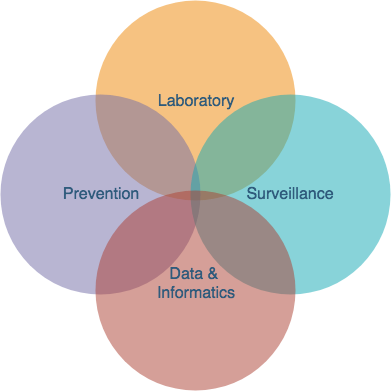Laboratory tests have been developed to help determine if a person has recently acquired HIV infection [1, 2, 3]. Antibody-based tests for recent infection (TRI) can help distinguish recent from long-term HIV infection [4, 5].
Rapid tests for recent infection (RTRIs), such as the Asante HIV-1 Rapid Recency Assay, help differentiate between recent and long-term HIV-1 infection in one testing device [8, 9, 10]. The test can be completed in 20 minutes, allowing the option for it to be implemented in routine HIV testing services (HTS).
Several factors may cause a test for recent infection to give a ‘recent’ result when, in fact, the person has had HIV infection for more one year [6]:
- Variable immune responses at the individual-level,
- Variable performance of the assay across diverse HIV-1 subtypes and across populations with naturally low viral loads, or
- Current ART use and advanced HIV disease.
To improve the classification of recent infection status, a recent infection testing algorithm (RITA) was developed. RITA incorporates the TRI result with other markers of chronic infection (e.g., low viral load, evidence of treatment) [7].
RTRI tests pave the way for a HIV recent infection surveillance system as part of routine HTS to detect and characterize recent HIV infection trends geographically and demographically to support HIV prevention activities.

- Murphy G, Parry JV. Assays for the detection of recent infections with human immunodeficiency virus type 1. Eurosurveillance, 2008, 13:pii=18966.
- Le Vu S et al. Performance of an immunoassay at detecting recent infection among reported HIV diagnoses. AIDS, 2009, 24:1773–1779.
- Parekh BS et al. Quantitative detection of increasing HIV type 1 antibodies after seroconversion: a simple assay for detecting recent HIV infection and estimating incidence. AIDS Research and Human Retroviruses, 2002, 18:295–307.
- Wei X et al. Development of two avidity-based assays to detect recent HIV type 1 seroconversion using a multisubtype gp41 recombinant protein. AIDS Research and Human Retroviruses, 2010, 26:61–71.
- Barin F et al. Development and validation of an immunoassay for identification of recent human immunodeficiency virus type 1 infections and its use on dried serum spots. Journal of Clinical Microbiology, 2005, 43:4441–4447.
- Centers for Disease Control and Prevention (CDC). Consultation on Advancing HIV Incidence Surveillance Summary. https://www.cdc.gov/hiv/pdf/statistics_cahivis.pdf. Accessed February 8, 2019.
- World Health Organization (WHO). UNAIDS/WHO Working Group on Global HIV/AIDS and STI Surveillance: When and how to use assays for recent infection to estimate HIV incidence at a population level, 2011.
- Soroka SD et al. Modification of rapid human immunodeficiency virus (HIV) antibody assay protocols for detecting recent HIV seroconversion. Clinical and Diagnostic Laboratory Immunology, 2005, 12:918–921.
- UNAIDS, Global HIV Strategic Information Working Group. Recent infection testing algorithm technical update: Applications for HIV surveillance and programme monitoring, 2018.
- World Health Organization (WHO). WHO Working Group on HIV Incidence Measurement and Data Use: Meeting Report, 2018.
